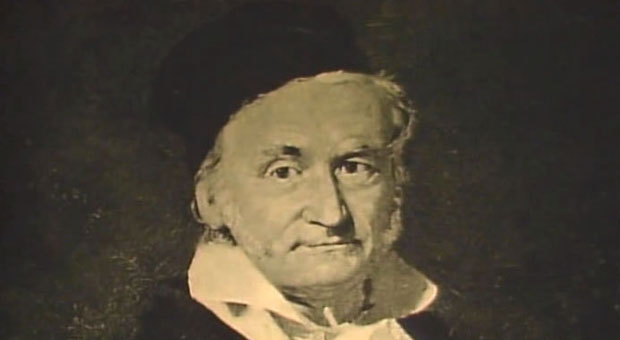 In a guest blog, Robert Wilne, NCETM Director of Secondary writes…
In a guest blog, Robert Wilne, NCETM Director of Secondary writes…
I don’t know if the much-quoted story of the young Carl Friedrich Gauss being asked to add up 1 to 100 and giving the answer after a moment’s thought is true, but if it is then it’s an excellent example of what being truly numerate means.
Gauss, it is said, didn’t calculate the answer by performing a hundred additions. Instead, he saw immediately that 1 + 2 + … + 100 is the same as 100 + 99 + … + 1, and putting the two sums together he realised he would get 101 a hundred times, i.e. 10,100.
The answer to the original sum therefore had to be 5050. The story is that his teacher set this challenge to keep the class occupied all morning; history doesn’t relate what polysyllabic Teutonic swearing erupted from him when young Gauss trotted to the front of the class and said ‘Finished, Sir’.
Gauss had deep ‘number sense’: he wasn’t a calculating prodigy, instead he saw the structure and the pattern of the numbers in the sum, and he exploited that to calculate the answer.
Gauss had deep ‘number sense’: he wasn’t a calculating prodigy
Of course, he needed some basic arithmetic skills – multiplying by 100, dividing by 2 – but what his method shows, and depends upon, is his conceptual understanding more than his procedural fluency.

Photo: www.famous-mathematicians.com
To be truly numerate you have to have both of these: if you look at GCSE papers of candidates who achieve E, F and G grades, you see that questions such as ‘Work out the total cost of five pens each costing 29p’ are usually answered by the sum 29 + 29 + 29 + 29 + 29 rather than the product 5 × 29.
These candidates have some fluency and some conceptual understanding – they recognise that ‘total’ means ‘add up’ and they can often correctly evaluate the sum – but the conceptual understanding is shallow because they don’t recognise that repeated addition is the same as (indeed, it’s a definition of) multiplication.
The conceptual understanding is shallow because they don’t recognise that repeated addition is the same as (indeed, it’s a definition of) multiplication
This is a great limitation, not just in exams – working out the cost of seventeen pens would be hugely inefficient, and an error would be highly likely to occur – but also in further study, future employment and adult life.
Imagine working out how many 71cm paving stones are needed for a 55m garden path with no confident conceptual understanding of division, only familiarity with subtraction.

Teaching numeracy certainly means ensuring that pupils develop number knowledge: they need to know that (e.g a fact such as 7 × 8 = 56), and to know how (e.g an algorithm for evaluating 27 × 38 accurately and fluently).
Imagine working out how many 71cm paving stones are needed for a 55m garden path with no confident conceptual understanding of division
But these are necessary not sufficient outcomes: pupils also need to develop confidence and imagination when looking at, and for, connections and patterns in and between calculations and numerical relationships. They need the deep understanding of knowing why an algorithm works or a number sentence is true, not just that it is. They need to be able to reason coherently:
- how they would complete a number sentence such as ’33 + 23 = 19 + 37′
- whether either, both or neither of ‘437 + 364 = 435 + 366’ and ‘437 – 364 = 435 – 366’ are true
- why 18 × 23 = 9 × 46
- what the value of 731 ÷ 91 × 7 × 13 is, irrespective of the dogma of BODMAS
- whether 1/3 is always, sometimes or never greater than 1/4
- why the standard algorithms for adding, subtracting, multiplying and dividing fractions are executed as they are
- whether a 25% gas price rise followed by a 20% gas price fall is overall an increase or a decrease.
Teaching numeracy, therefore, from Early Years to KS5, isn’t only about teaching number facts: bonds, tables, rules. If we want our pupils to develop the mastery that we could call ‘number sense’, we also have to show them and explain to them and use with them powerful and accurate language, models and representations, and they need substantial and recurring opportunity and practice to internalise and understand these.
There can’t be one explanation of multiplication in Year 1 and a different one in Year 4; there can’t be one explanation how to add fractions in Year 5 and a different one in Year 8.
There can’t be one explanation of multiplication in Year 1 and a different one in Year 4; there can’t be one explanation how to add fractions in Year 5 and a different one in Year 8.
Easier said than done, agreed, but the difficulties in doing so – which are linked to factors such as teacher subject knowledge, school cultures of pedagogy and CPD, pupils’ exposure to negative mindsets, opportunities for cross-phase communication – are nothing compared to the difficulties our pupils will face in the global future in which they will live and work if we don’t commit to meeting this challenge.
Robert will be talking further about Making Sense of Number Sense at Leading and Managing Numeracy Across the Curriculum – a one-day event for senior leaders and numeracy coordinators in London on Monday 13 July 2015.
